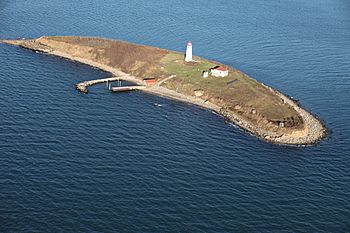Falkner Island facts for kids

Aerial view after Hurricane Sandy
|
|
| Geography | |
|---|---|
| Location | Long Island Sound |
| Coordinates | 41°12′39″N 72°39′11″W / 41.210880°N 72.653190°W |
| Area | 2.87 acres (1.16 ha) |
| Administration | |
|
United States
|
|
| State | Connecticut |
| County | New Haven |
| City | Guilford |
| Demographics | |
| Population | 0 |
Falkner Island (also called Faulkner's Island) is a small, crescent-shaped island. It is about 2.87-acre (1.16 ha) in size. You can find it in Long Island Sound, about 3 miles (5 km) off the coast of Guilford, Connecticut, United States.
People have visited this island for thousands of years. The Native Americans called it "Massancummock." This means "the place of the great fish hawks." In 1641, early settlers bought the island from the Mohegan tribe. Later, in 1801, the United States government bought it.
The Falkner Island Light was built in 1802. It is the second oldest lighthouse in Connecticut. This lighthouse is listed on the National Register of Historic Places. It helps guide ships even today. The island is also part of the Stewart B. McKinney National Wildlife Refuge. It is an important home for many birds, especially the roseate tern. Over time, the island has gotten smaller due to erosion.
What's in a Name?
The first name for Falkner Island came from the Native Americans. They called it "Massancummock" in the Quinnipiac language. This name meant "the place of the great fish hawks." It described how the island was used, not who owned it.
The first European to explore the area was probably Adriaen Block around 1614. Early English settlers called it "Falcon Island." This name likely came from the Native American name, which referred to birds like osprey. The Dutch maps called it "Valcken Eylandt."
The name later changed to Faulkner Island. This might be because the Faulkner family lived there in the 1700s. When the U.S. government bought the island in 1801, the official paper said "Faulkners." In 1891, the United States Board on Geographic Names officially named it "Falkner Island." However, many people still use "Faulkner" today.
Island History
People have been active on Falkner Island for thousands of years. Scientists found an ancient stone tool from 1000-3000 B.C. This shows that people visited the island a very long time ago. Native Americans likely used the island for fishing and hunting in the summer. It was not a place where they lived all year.
Europeans first arrived in the early 1600s. In 1641, settlers from Guilford bought the island. They bought it from Uncas, a leader of the Mohegan tribe. The island then belonged to different families. In 1801, the government bought it to build a lighthouse.
The island was home to lighthouse keepers and their families until 1976. During the War of 1812, British soldiers landed on the island. They told the lighthouse keeper's wife to keep the light on. Later, the keeper had to turn the light off. The British then threatened to destroy the lighthouse if it stayed dark. So, the light was turned back on.
Today, a building on the island is used by interns. These interns study the endangered roseate terns. Sadly, big storms like Hurricane Irene and Hurricane Sandy have damaged the island. They have greatly reduced the birds' nesting areas.
Erosion is a big problem for the island. In 1639, it was about eight acres. By 1987, it had shrunk to 2.87 acres (11,600 m2). Experts worry that the island could keep shrinking. They are working to protect it.
Falkner Island Light
The Falkner Island Lighthouse was built in 1802. President Thomas Jefferson ordered its construction. The lighthouse has had three different keeper's houses. The first was built in 1802. It was rebuilt in 1851 and again in 1871.
In 1976, the keeper's house burned down. The lighthouse was fixed and became automated in 1978. This means it runs by itself without a keeper. A group called the Faulkner's Light Brigade helps take care of the lighthouse. They have been working to restore it since 1991.
You cannot visit Falkner Island during certain months. This is from May to August. This rule protects the roseate terns during their nesting season. The Falkner Island Lighthouse is the second oldest lighthouse still standing in Connecticut. It is an important historic site.
Island Wildlife
In 1985, Falkner Island became part of the Stewart B. McKinney National Wildlife Refuge. This refuge helps protect wildlife. The island is very important for birds. It is home to over 95% of the Common Terns that nest in Connecticut.
It also has one of the largest groups of Roseate Terns in the northeastern United States. About 45 pairs of these birds nest here. The roseate tern is an endangered species. This island is the only regular nesting spot for them in Connecticut.
Another bird, the American oystercatcher, also nests on the island. One or two pairs are seen nesting each year. Even though efforts were made to stop erosion, hurricanes have caused damage. Hurricane Irene and Hurricane Sandy greatly reduced the terns' breeding habitat. Their nesting area shrank to just 50 square metres (540 sq ft). In 2014, the dock, which was damaged by Hurricane Sandy, was rebuilt.


